Last Updated on June 22, 2023 by asoulwindow
Shri Chandrashekhar Azad was one of the most important freedom fighter which Uttar Pradesh had produced. No one can deny the important role Uttar Pradesh played in India’s fight for freedom against the British. The huge state produced many courageous freedom fighters. U.P. was the playground for many important events in the 19th and 20th century which eventually led to the hard earned freedom of India.
During my 7 years in Navi Mumbai, I made many visits to my hometown in Lucknow. I always made sure that I picked at least 5 or 10 samosas at Unnao junction every time the ever punctual and everyone’s favourite Pushpak Express (Mumbai – Lucknow) halted in Lucknow. For many years Unnao meant Samosa (The taste is special) until Vineet Singh, an Unnao Resident and a talented travel and documentary photographer, casually mentioned the importance of Badarka village near Unnao over a chat.

Despite being born and brought up in U.P., I was clueless that this nondescript village is so significant in India’s freedom struggle movement. Unfortunately very few people know that it was the hometown and birth place of one of India’s greatest freedom fighter Shri Chandra Shekhar Azad. What made it interesting is the controversy regarding the real birth date and birth place of Azad.

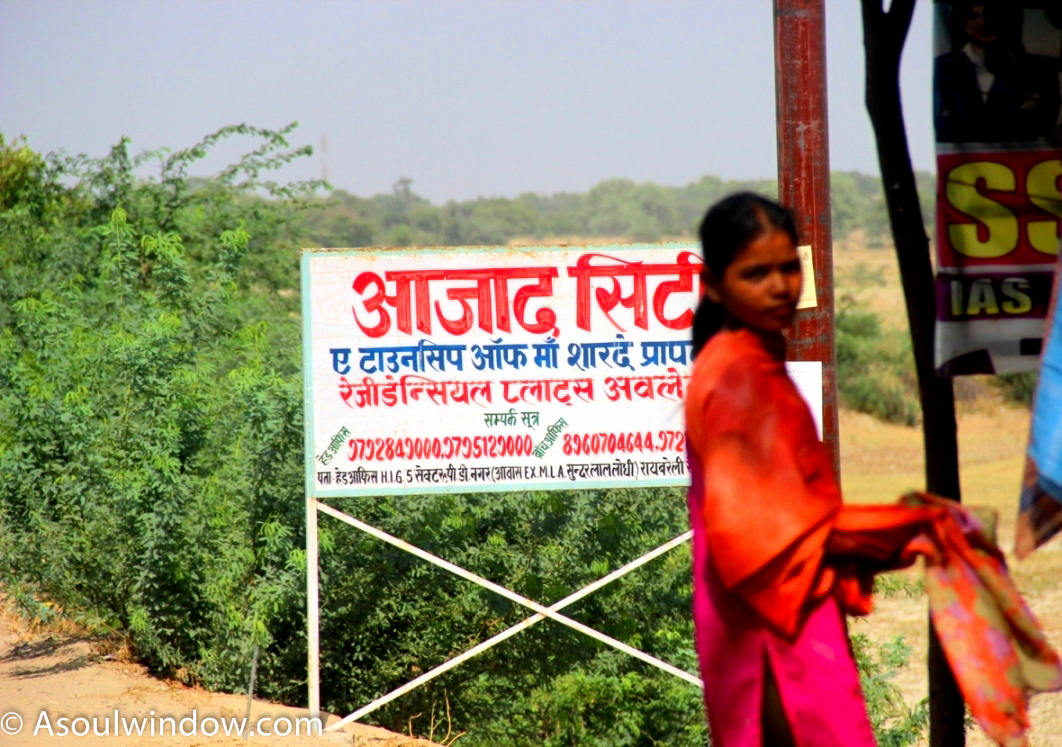
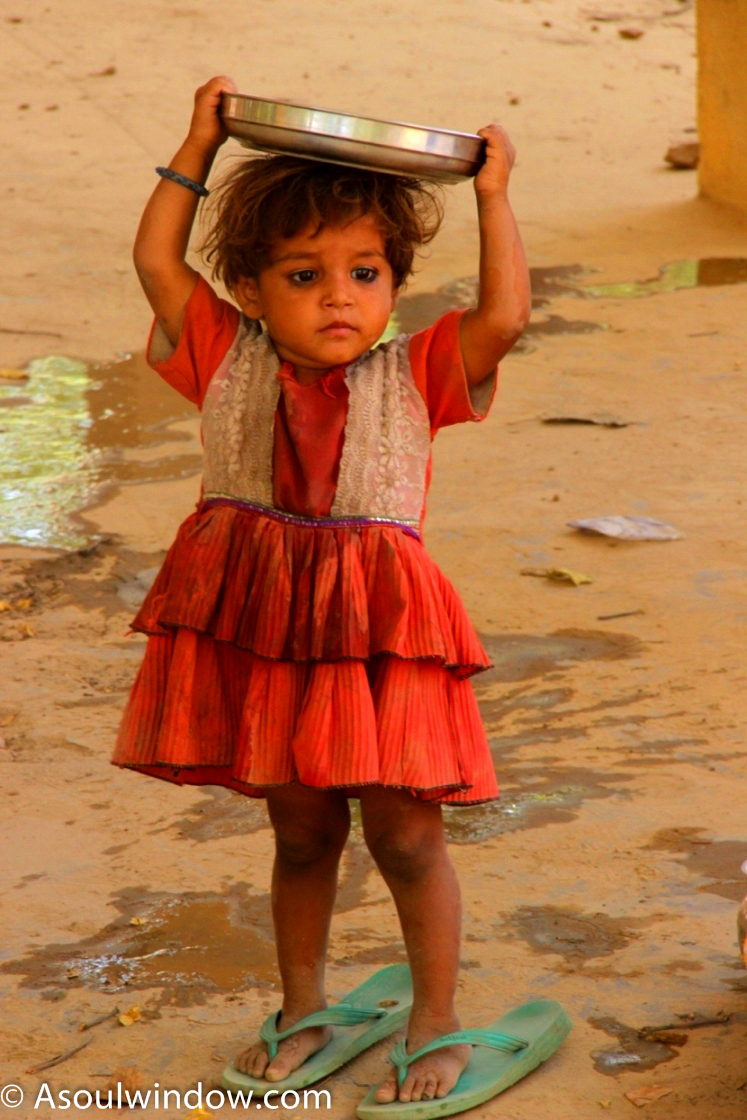
Pictures above: 1) Vineet asking for direction, 2) a little girl at The Amar Shaheed Chadrashekhar Azad Dwar 3) Upcoming Housing Societies coming up in Azad’s name in Badarka, Unnao (Pls. click to enlarge)
I joined Vineet one hot afternoon in June to unearth the truth of India’s much revered and feted freedom fighter, fondly called by people as Azad (Free). While Vineet drove his car along the 12 km long dusty lanes of Badarka, my eyes were constantly peeled to spot any signs which mentioned the glorious past of the place. Tragically, except the signboard of an upcoming residential building named ‘Azad City’, cashing on his name, nothing else seemed to be celebrating the glorious past of the place. None of the villagers knew the location of the exact house of Shri Chandrashekhar Azad or his neighbour Shri Rajan Shukla’s residence.
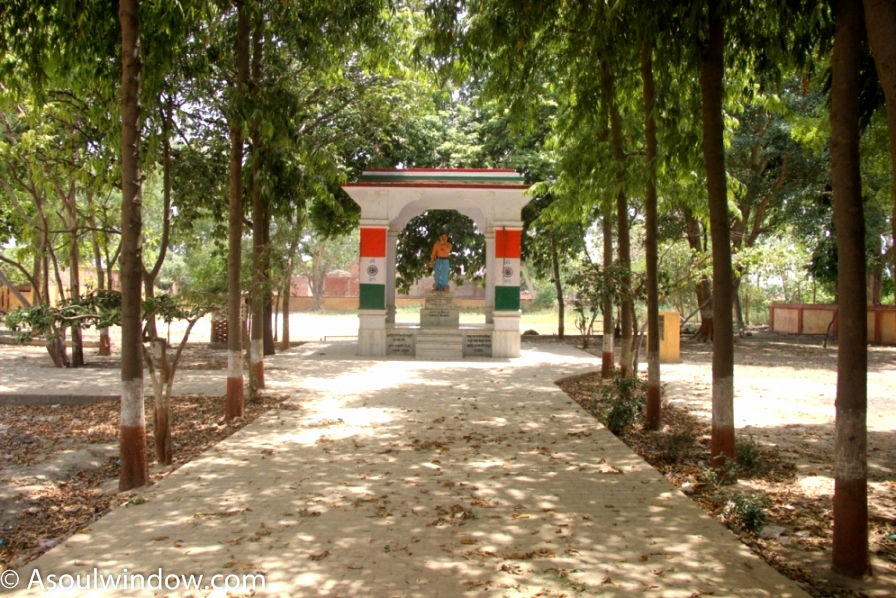
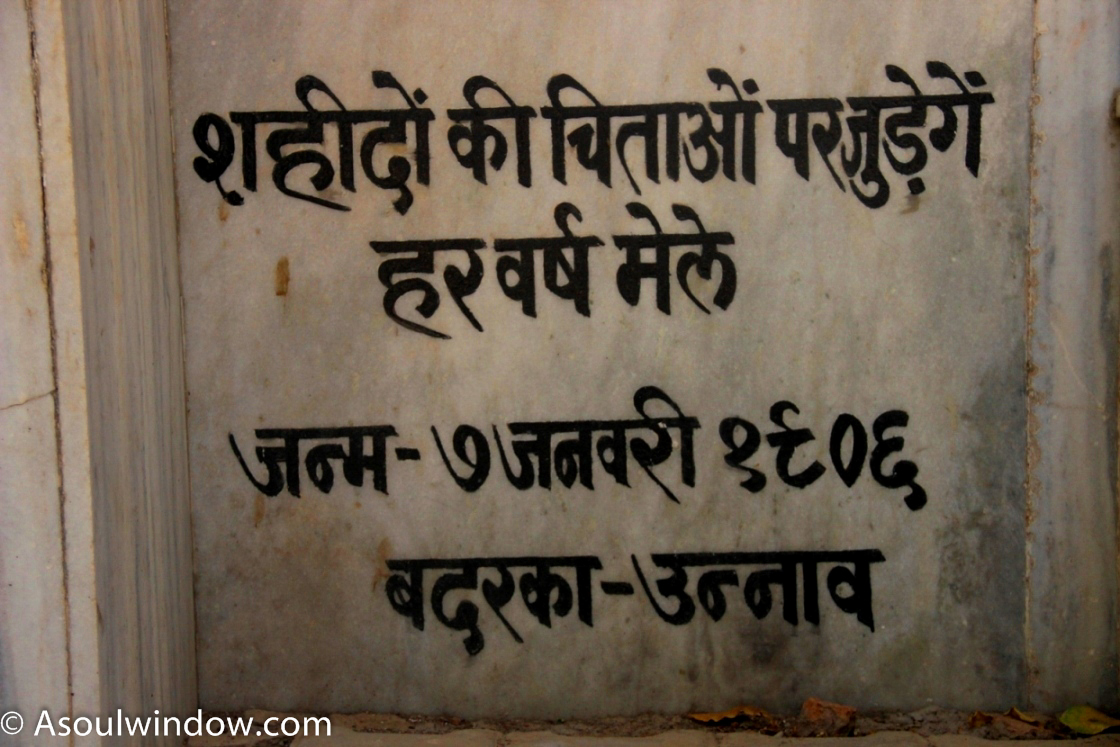
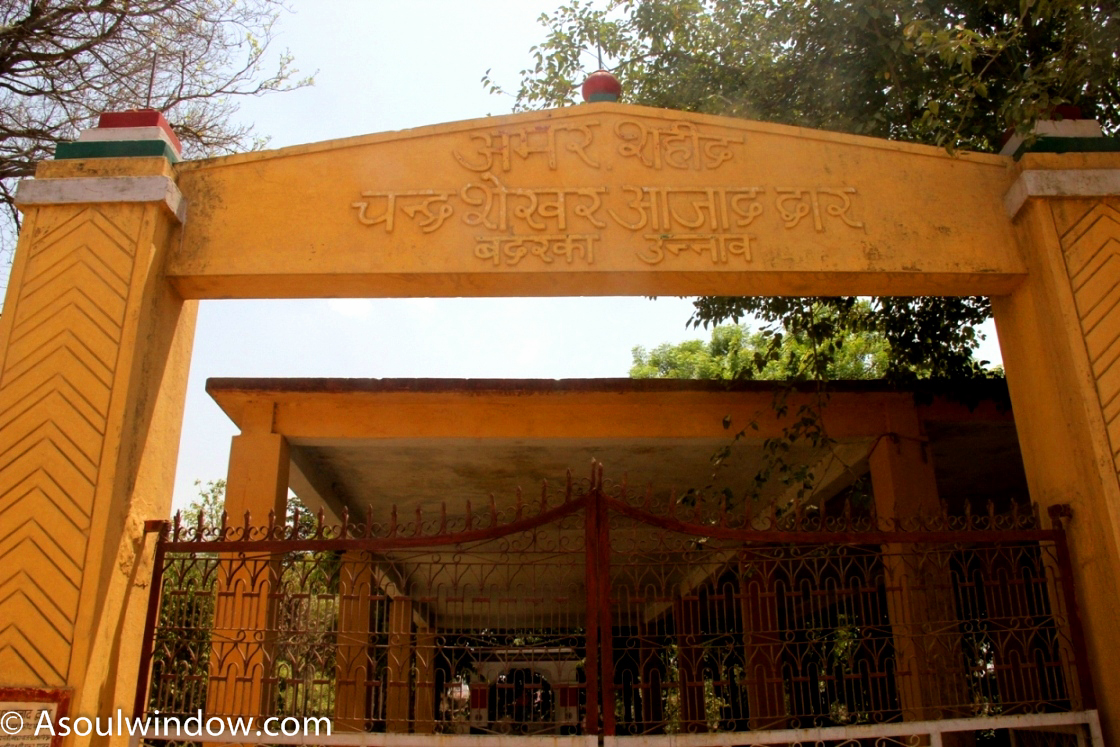
Pictures above: The Amar Shaheed Chadrashekhar Azad Dwar (Pls. click to enlarge)
After much probing, one villager directed us to a memorial built to commemorate him. We entered the empty grounds populated by few monkeys and daily wage labourers toting kids with running noses. Azad’s statue built in the campus of the poorly maintained and dusty large ground attracted my attention. The statue was a typical Azad statue which showed him proudly rolling his moustache with machismo.
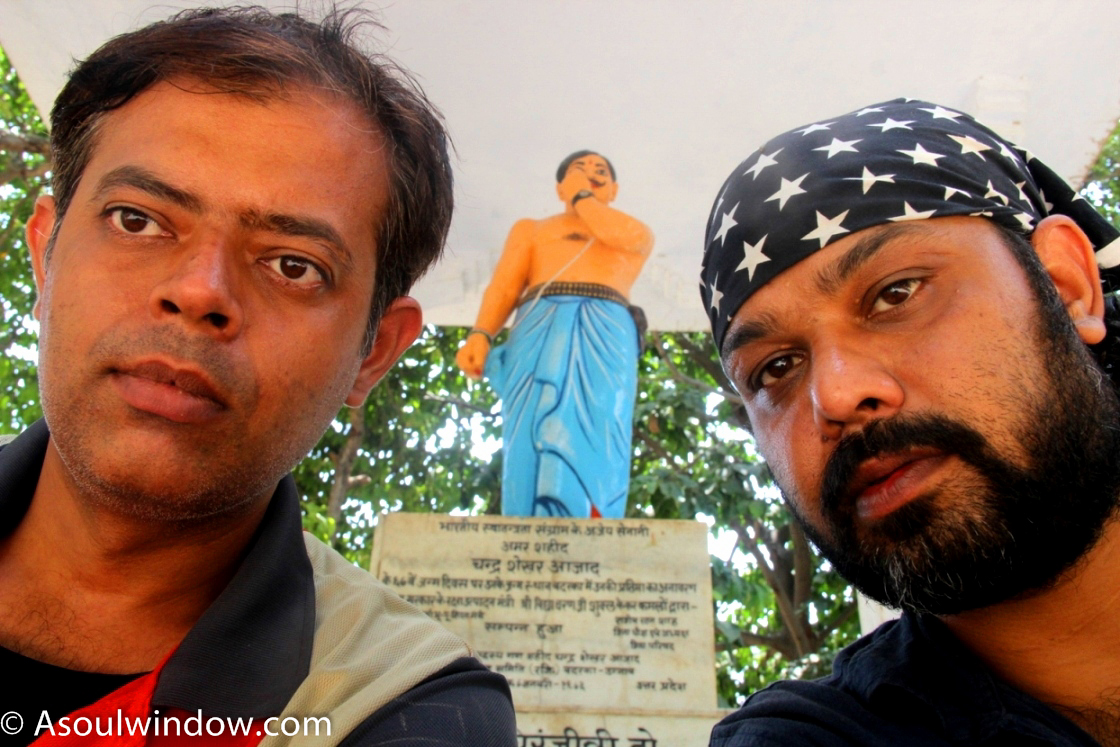
The Amar Shaheed Chadrashekhar Azad Dwar was a memorial which was built to commemorate the contribution of Azad towards India’s freedom struggle. On 7th January every year, thousands from across India congregate at this ground to celebrate the birth anniversary of Azad over 3 days (6th,7th & 8th January). The District Magistrate helms the opening ceremony. The tradition of this ceremony dates back to the year 1932, just a year after Azad was martyred. The tradition was started by Azad’s mother to keep his memory alive. Many freedom fighters, politicians and friends of Azad attended the first event which was grand and celebrated with much fanfare.
Bigwigs like former Indian Prime Minister Smt. Indira Gandhi, Professor Nakamura (Foreign delegate from Tokyo University in 1973) and scores of former Chief Ministers and Governors have paid visit to Badarka. Mr Shukla recounted a story about Professor Nakamura. When he heard about the birth place of Azad during his stay in Delhi, he got curious and visited Badarka along with dozen more delegates. Moved by Azad’s story he promised to build a statue in Tokyo University in Azad’s memory. He communicated the same to Shukla family via snail mail once he fulfilled his promise. Mr. Rajan recalled fondly how much he liked the ‘buknu’ powder made by his mother. He requested to pack some for him and carried it all the way to Japan. Indian Freedom fighters like Shri Ram Prasad Bismil have also visited Mr. Shukla’s home at some point.
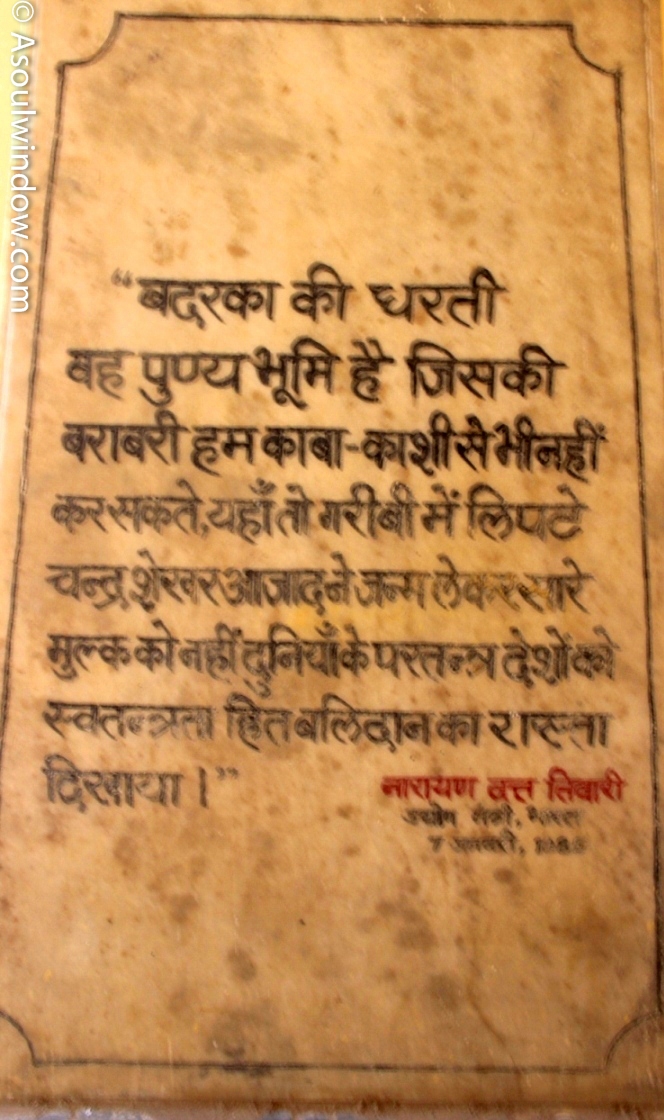
In those days during the annual celebrations, veterans from Badarka and freedom fighters (many of them also the friends of Azad) used to recite unknown anecdotes from Azad’s life in their passionate and emotional speeches.
It is said that those speeches were so poignant that mere words would move the crowds to tears. Over the years, things changed. These days, celebrations are marked by political speeches and kids performing in cultural shows. All of a sudden, people celebrate and acknowledge the glorious past of Badarka, for merely 3 days! The show is hijacked by politicians these days. Politicians usurp the podium, make umpteen promises and then disappear until next 7th January, Mr. Rajan Shukla rued.
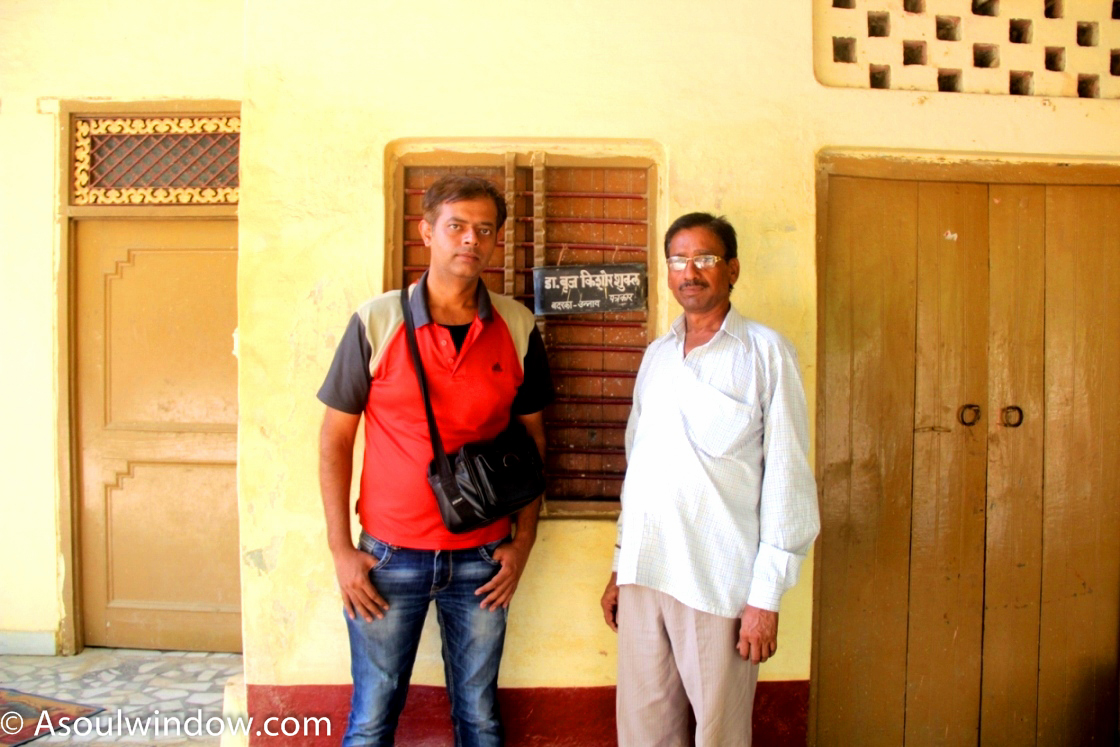
Long back, the then Chief Minister of U.P. promised to improve Badarka’s fortunes by developing it as an international tourist destination, even building quality schools and medical facilities. Predictably, it never materialised. Mr Shukla said disdainfully that despite its proximity to Lucknow, which is the capital and the political axis of U. P, Badarka has been given a step motherly treatment despite its historical significance. He lamented that Badarka lacks even basic education and medical facilities, let alone any development projects. For a population of above 5000, Badarka has only one school upto standard 8th. Even schemes like Mahatma Gandhi National Rural Employment Guarantee Scheme failed to turn the fortunes of Badarka. No wonder, many youngsters are choosing to migrate to other cities to build a future for themselves.
THE CONTROVERSY REGARDING THE BIRTH DATE & BIRTH PLACE OF AZAD
The birth place and the birth date of Azad is disputed. Some records claim 23rd July, 1906 and Alirajpur in M.P. as Azad’s birth date and birth place respectively. Some official records mention Azad’s birth date as 7th January, 1906 and his birth place as Badarka. Smt. Jagrani Devi, Azad’s mother was clueless about Azad’s martyrdom until March 1931, a month after Azad killed himself when gheraoed by British officers at (then) Alfred park, Allahabad. Pandit Ramlaal ji Shukla, father of Shri Rajan alongwith Shri Sampoorna Singh, a freedom fighter visited her and broke the tragic news to her. Refusing to believe it, she cried for hours and collapsed. When they requested her to show to them a belonging of Azad, she showed them Azad’s ‘Jhabla’ (Clothes for infants) and janam kundli (Natal Chart/Birth Chart).

She refused to hand over the hand woven jhabla which she lovingly knitted for Azad but gave away the ‘janam kundli’ of Azad to Shri Sampoorna Singh, based upon which he did the ‘shilanyas’ (laying the foundation) of his memorial with fanfare. Mr. Rajan presented to me an original photograph of Azad’s mother and an original copy of Janam Kundli. It clearly mentioned Azad’s date of birth and place of birth. The tradition continues to this date. The family of Mr. Ichcha Shankar Shukla, Azad’s classmate till class 4th, claims the same date. During British rule it was a hard task to openly celebrate the Azad’s birth anniversary or build the memorial because the British officer regularly frequented Badarka and sternly warned the locals to not even take his name, leave alone build a memorial. They feared that his story might inspire people and produce more Azads. The first birth anniversary was surreptitiously celebrated at Azad’s family home. Till the time India achieved independence from British rule, the location used to change every year. Many villagers volunteered to celebrate it in their home in a clandestine manner.

Badarka was the place where the first Azad Memorial was built in 1958. The folklore has it that such was the aura of Azad that the memorial attracted huge crowd from across India in those days. Even today the magic continues, albeit on special occasions. In 2006, a parliament member from Karnataka, questioned the Central government about what steps they are taking to honor Azad’s birth centenary. The centre realized that his birth place is still under dispute. Upon the study and verification of the official records, 80 % of it mentioned Badarka as Azad’s birth place. The other 20 % claimed Alirajpur as his birth place. When Centre verified the records with Uttar Pradesh secretariat, they found that Badarka was mentioned as his birth place. The state and centre team then sent a team to inquire on the same minutely to Bhabhra village, formerly under Jhabua district, now a part of Alirajpur district in M.P. Badarka was finally announced as his birth place formally by the Government after much verification and research.
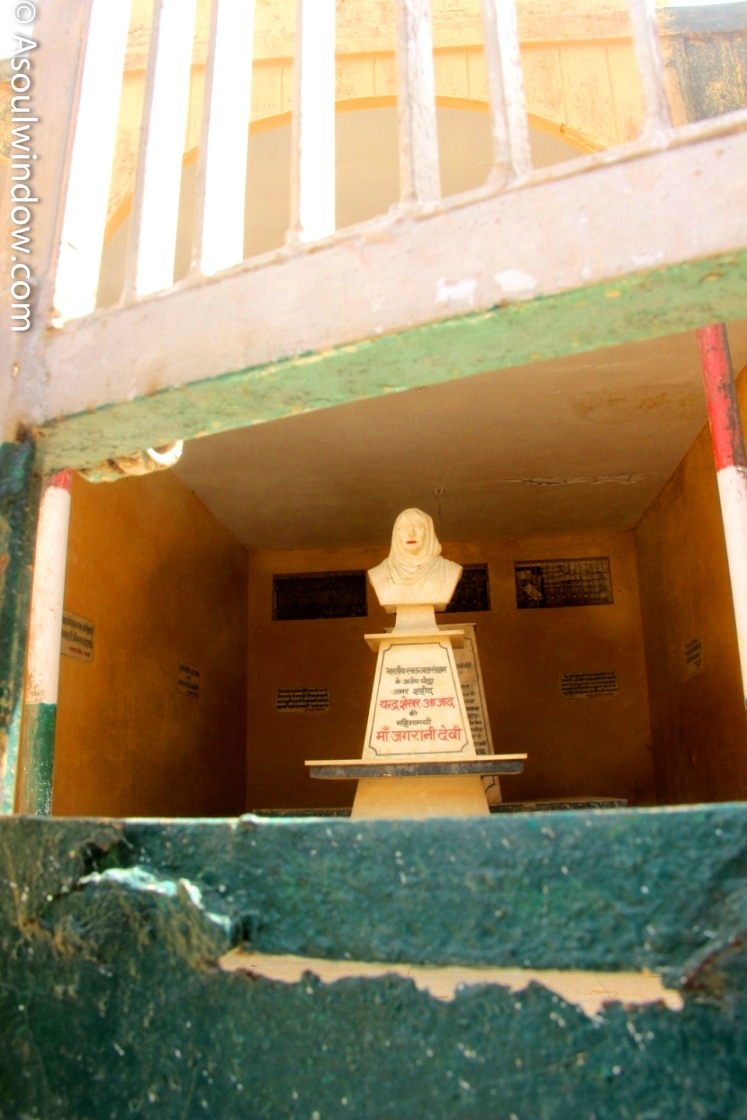
Relying on Vineet’s memory of an earlier visit long time ago, we managed to find the house of Mr. Rajan. The hot June afternoon forced the entire village to stay cocooned in the cooler climes of their homes. We broke the silence of the village as we knocked Mr. Rajan’s door, He was amused at our arrival. Not many expect visitor during hot summer noons. As he recounted stories of Azad and his home, cows busied themselves in chewing cud and monkeys fooled around.
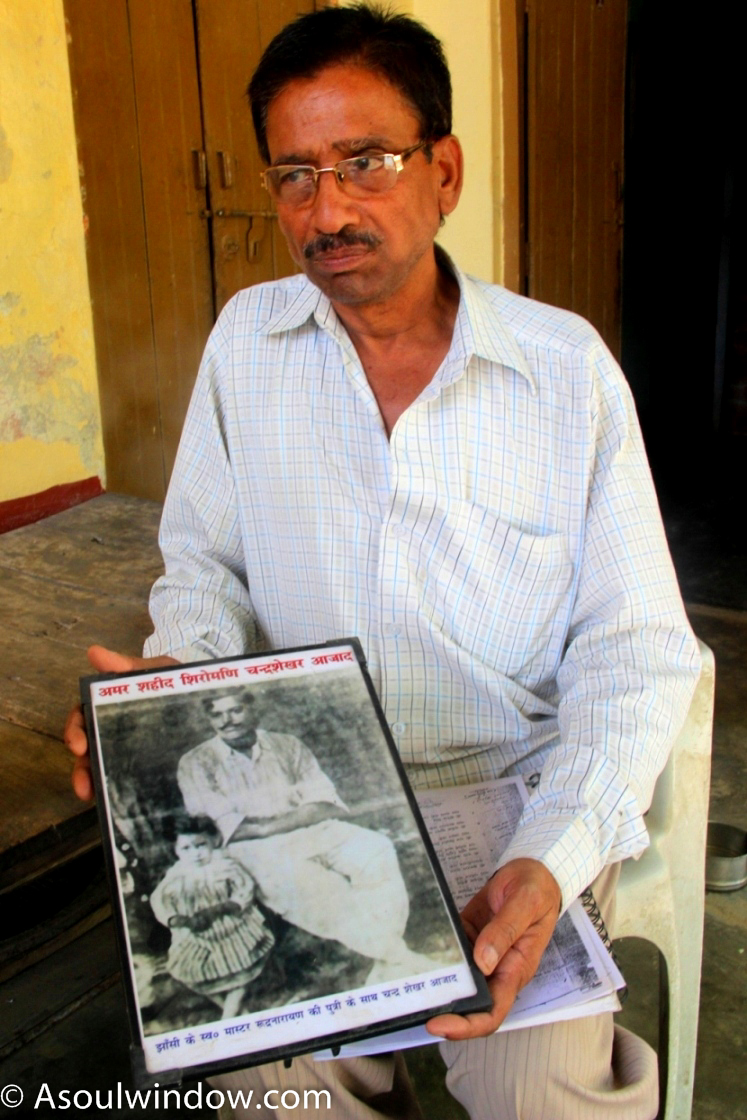
His family maintained close bond with the family of Azad, especially his mother. In those days, both the families used to visit each other’s house almost on daily basis. Smt. Jagrani Devi, mother of Azad, used to spend hours just chatting at the house of Mr. Rajan. Smt. Jagrani Devi, the third wife of Pandit Sita Ram Tiwari gave birth to Azad and Sukhdev. Both of them were born in Badarka. Sukhdev passed away at a young age. A self respecting woman, Smt. Jagrani Devi never approached anyone for help even when she was the only surviving member of her small family. Mr. Rajan recounts that often she used to share her sorrows and shed tears in the memory of Azad at his house and that of Shri Ichcha Shankar Shukla, the 2 families with whom she shared deep ties. Roads and memorials were built in her memory in Badarka after she bid adieu to the world in 1951. Shri Braj Kishore Shukla (Father of Mr. Rajan), a freedom fighter himself, dedicated his entire life in lovingly preserving the memories of Azad.
He started a trust called – Shaheed Chandra Shekhar Azad Smarak Trust Samiti to facilitate the same. In those days many revolutionaries were involved in the committee. Established in 1960, its goal was to rekindle the interest of young people in Azad and improve the living standards of Badarka. The committee did succeed in turning a dirt road into a 16 kms long road known as Shaheed Chandra Shekhar Azad Marg. It also implemented the ‘pey jal yojna’ which supplies water to the locals. Mr. Rajan, 65 years old is taking that legacy forward. He passionately presented before us the old files, well preserved newspaper cuttings and original documents and pictures which narrated the story of Azad.

Mr. Rajan was mentioning about Azad’s home every now and then. It piqued my curiosity and I requested him to narrate the rest of the story at his house, now a memorial. The memorial called ‘Azad Mandir’ was inaugurated on 7th January, 1988 by Shri Gopi Nath Dixit, the then governor of U.P. Its foundation was laid on 7th Jnauary, 1985 by the then C.M. of U.P. Pandit Narayan Datt Tiwari. Located just 5 minutes away from his house, I was losing patience to see it for myself. As Mr. Rajan continued talking, I stole glances through the corner of my eye, distracted by the few village kids, ruins of ancient haveli and tethered buffaloes. The first sight of Azad’s house humbled me.
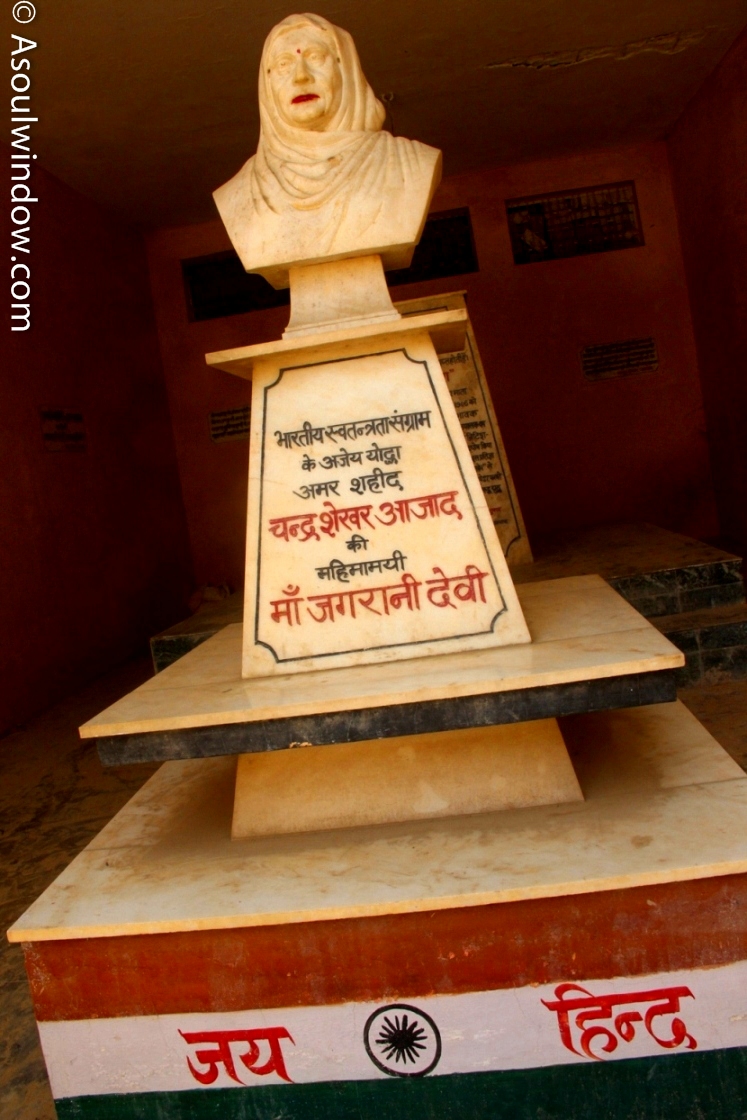
Now a memorial, it was once a hut built of wood and mud. If we compare with modern apartments, it was even smaller than a studio flat. It was just a small room without any kitchen or attached toilet. In comparison Mr. Rajan’s home and others’ home was much bigger. I reckoned that greatness must always be defined by ‘karma’ and not privilege. Realising that such a great freedom fighter had such modest roots made me reflective.
I left my slippers outside the metal gate, which is never locked. Despite the poor maintenance, the locals revere the place and remove the footwear before entering, just like they do in temples in India. I jump, at times to avoid resting my feet on a thorn, at other times to avoid the hot floor. The tethered cows at the front house guard the commemorative memorial. The floor was covered in dust and thorns were lying here and there. The statue of Smt. Jagrani Devi stood tall amongst all the muck, as if still smiling with pride! Patriotic slogans which evoked the freedom struggle were painted on yellow walls.
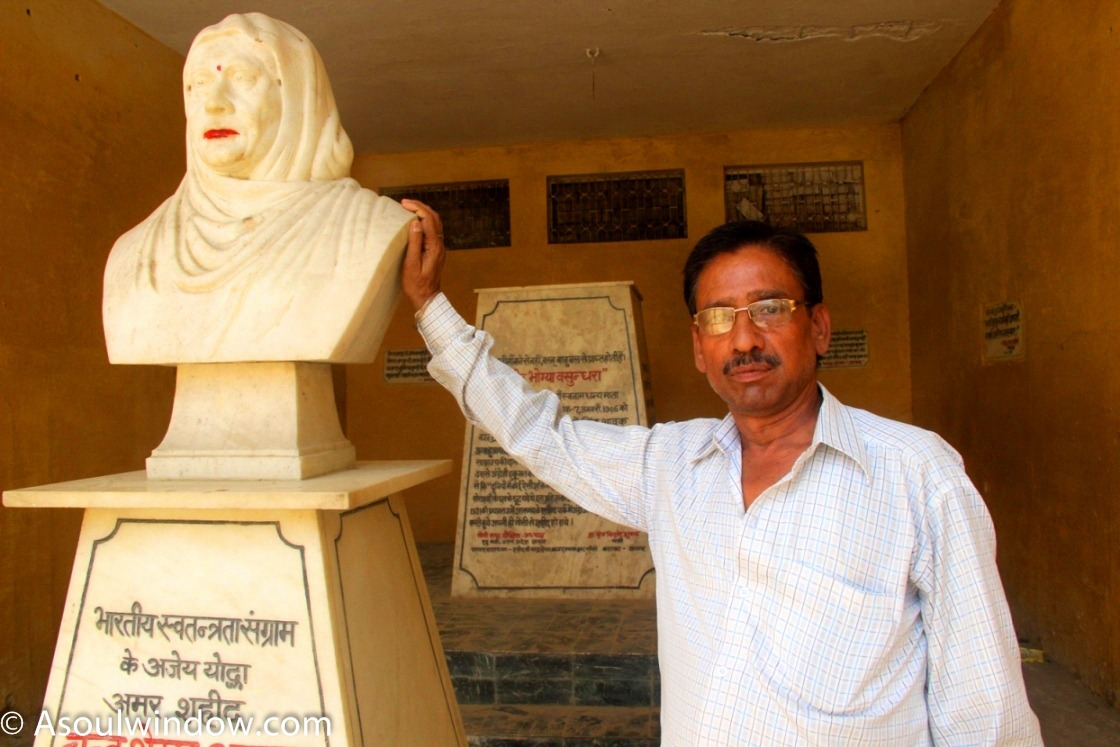
After finding a spot in shadow, Mr. Rajan recited the escapades of Azad with passion. The tales which turned Chandu into Azad and made him great! Mr. Rajan pointed towards a plaque which addressed Azad as ‘Son of Lion’ (Singh Shaavak). He fondly narrated to me and Vineet about an anecdote of Azad’s childhood in Badarka. Azad was taking his lessons under a makeshift open air school, with a ‘chappar’ roof, he was distracted when some British officers harassed the locals from the ‘pasi’ community. They started bundling all the belonging of a certain Kallu Pasi. The ‘daroga’ (Inspector) beat him up, turning his body red with blood when he protested. Little Chandu, (Azad’s nickname) found it hard to look at it and do nothing. The rebel kid in him made him hit the cops and run away. The furious cops found his home and interrogated his petrified father. Then Azad narrated the entire sequence and said that he did not like what he saw and hit them. It was one of the first instances when Azad displayed a rebellious nature, valour and fearlessness.
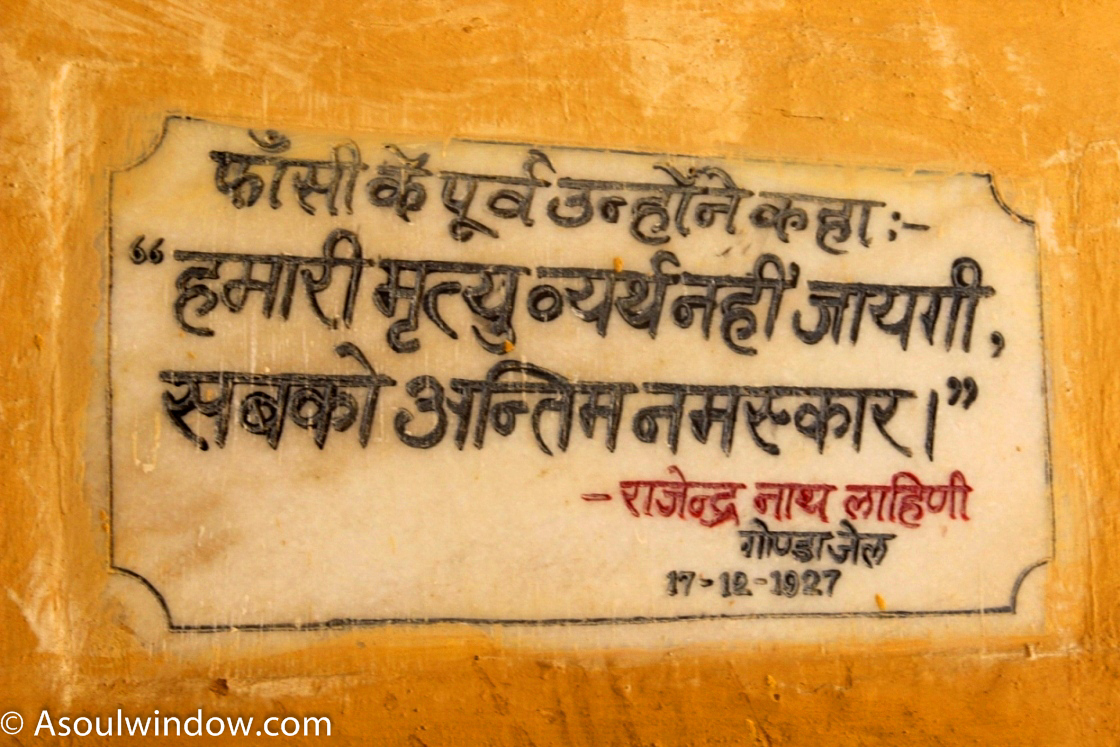
Mr. Rajan ji told me a story of Azad which not many know. A certain Mr. Ram Lakhan Awasthi, inspector in Alirajpur, hired father of Azad as a gardener at a paltry salary of Rs. 5 per month. Azad was around 13 years old when the family had moved to Alirajpur. Bored and disinterested in living in a remote tribal area, Azad agreed when a merchant asked him to accompany him to Mumbai. Odd job of painting a ship and later dish washing dishes at a tea shop sustained him in Mumbai, then Bombay. A Sanskrit teacher Shri Nand Kishore Gupta spotted him washing dishes and could make out that the child belonged to a decent family. He asked him his residence details, his name and the reason why he was washing utensils.
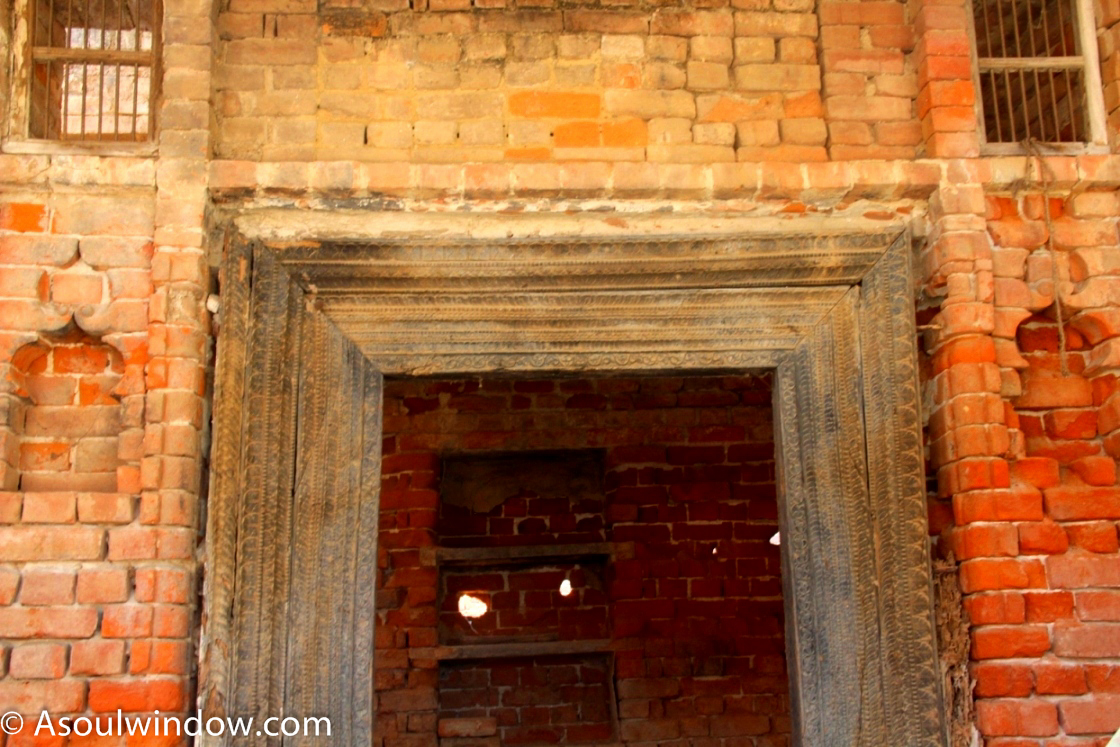
He convinced him to come to Varanasi and offered him food, shelter, education, clothes and a monthly allowance at Benaras Sanskrit Vidyapeeth. Azad moved to Benaras. At the tender age of 15, when adolescents are engaged in frivolous activities, he along with the students of his college participated in a procession chanting ‘Bharat Mata Ki Jai’ (Long Live Mother India) and Inquilab Zindabad (Long Live the Revolution). Azad led the procession with a flag in his hand. The British confronted the procession and tried to stop it. They asked Azad to throw away the flag and retreat. He taken to the magistrate upon arrest. What happened next is history. Here is what Azad answered to the questions posed by Magistrate.
Name : ‘Azad’(free)
Father’s name : ‘Swadheen’ (free)
Address : ‘Jail’
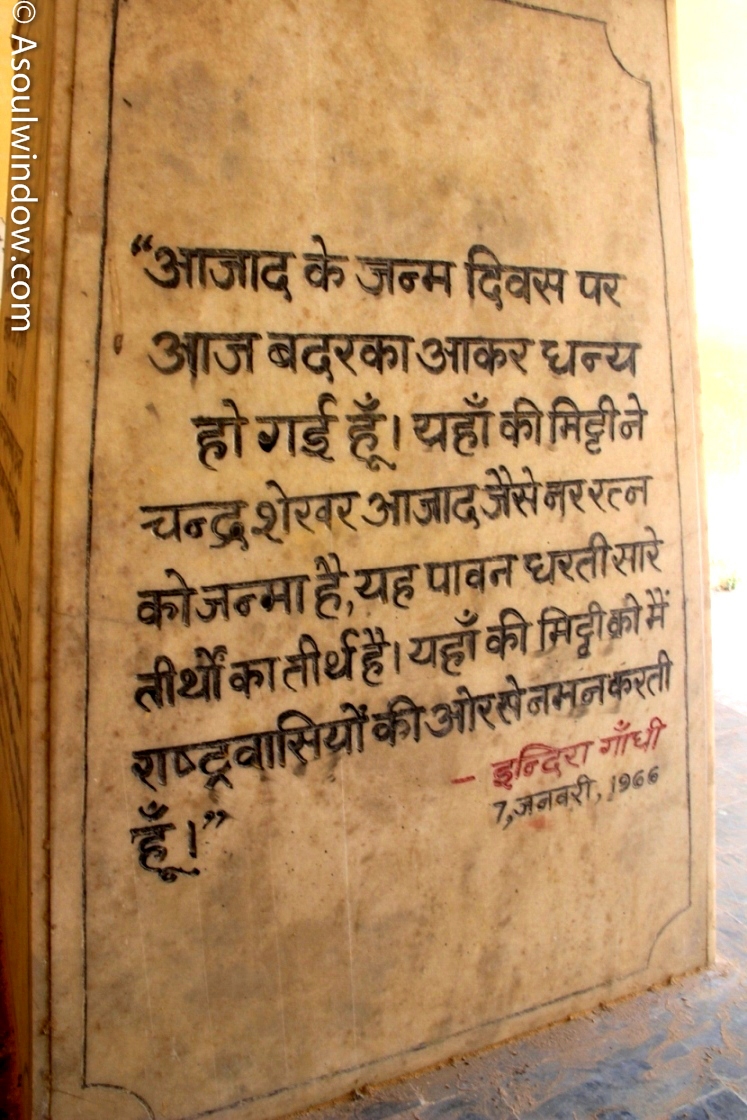
The magistrate, annoyed with his bold replies, ordered 15 lashes to be whipped on his exposed body with leather belt (dipped in hot oil). He would utter, ‘Bharat Mata ki jai’ and ‘Vande Mataram’ at each lash unflinchingly. After the ‘punishment’, his blood soaked body was dumped on the road. His pictures and story were carried in newspapers of that time. This event made him a household name.
His medication was taken care of by Shri Sampoornanad, a close family friend. Later, upon healing Azad addressed a crowd at a public meeting. It is said that the crowd was so huge that they had to put a chair above a table on a cot so that everyone could see him. He declared boldly from the stage, “We are free (Azad) from today onwards!! The British will never be able to kill us.” Years later, he kept his words when he shot himself as British officers attacked him.

I probed Mr. Rajan why was there so much confusion regarding his birth date and place. His theory seems plausible. As per him most of writers who wrote on him did not belong to Badarka. Unfortunately, no one from Badarka documented his life in words. On the other hand, other, including his jealous rivals, minted money by penning books on his life with half baked facts. Mr. Rajan told me that some so called revolutionaries from Bundelkhand were rivals of Azad. Azad had even ordered to get them eliminated since they were involved in anti national activities such as acting police informer. Tragically, after Azad was martyred, the same set of people wrote books on him with an agenda of raking in the moolah. They even spread fabricated stories like Azad, who was a Brahmin, ate meat in order to gain political mileage. This resulted in wrong information masquerading as history.

Mr Rajan rues that if Azad was still around, India’s destiny would have been something else. Not only did Azad have a vision of a free India but also an India without cast, creed and caste. I contemplated at the seemingly impossible dream of an egalitarian society, took a deep breath and said my thanks and good bye.
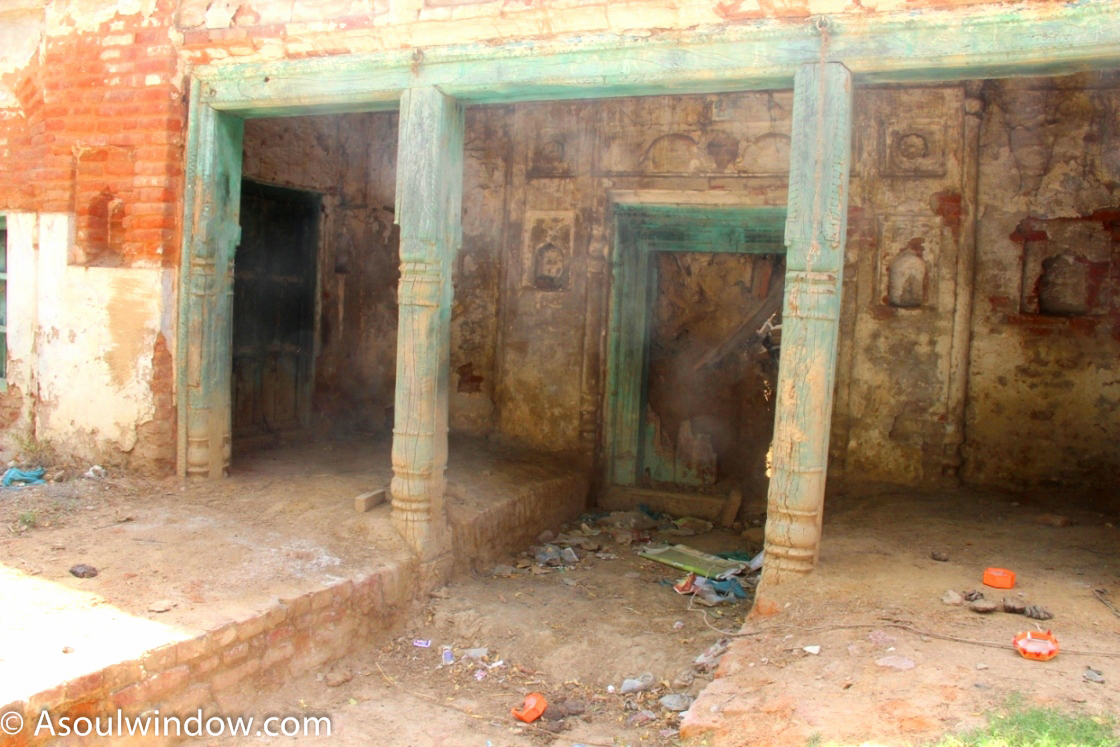
White Palace Of Badarka – The ruins of this huge building is walking distance from Azad’s home in Badarka. The British christened it such. The 500 year old fort was built by Mughal emperor Jehangir. As per historian Shri Lakhpat Rai Sharma, Jehangir transported and buried large amounts of treasure in the underground cellar of the mysterious fort. In a bid to recover the treasure, the British did much damage to the palace as they tried to demolish it. One can still see the cannon shots. The British managed to loot much of the wealth. However they could not find any treasure. Also called Fort of Harivansh Rai, the massive fort comprises of 7 stories, 4 above the ground and 3 below it and is built on the area of 4 hectares. The folklore has it that a 25 kms long tunnel passes near the fort with doors at regular intervals. The religious idols recovered from a temple within the campus have now been moved to another temple nearby. Mr. Rajan told me a quirky fact: even if a small stone falls off its walls, it always drops within the fort and never outside it. Azad used to sit and plan the next missions here along with his friends. It is said that they escaped from the tunnel when British Officers attacked the fort. The mutiny of 1857 did most damage to the fort.

Other significant places in Uttar Pradesh which played a major role in India’s freedom struggle.
U.P. played a vital role in the freedom struggle of India. While many revolutionaries nourished the soil with their blood, many politicians discussed and shaped the future of India on the land of U.P.
Kakori Station: 91 years have passed but the details of ‘Kakori Kaand’ also known as Kakori Revolution is still etched in the conscience of Indians. On August 9, 1925 near Kakori station, HRA (Hindustan Republican Association) members overpowered the train heading towards Lucknow and looted the money which belonged to the British. Led by revolutionary Shri Ram Prasad Bismil, he was accompanied by other legendary freedom fighters such as Shri Chandra Shekhar Azad, Shri Ashfaqulla Khan, Shri Sachindra Bakhshi and others. Everyone involved were arrested except Azad.
Chandra Shekhar Azad Park: Known as Alfred Park during Raj, British built the park in Allahabad. Today, it is remembered as the park where Azad breathed his last. He preferred ending his life under a tree rather than surrendering to British who gheraoed him. The prized possession of the nearby museum is the .32 bore colt pistol which Azad owned. Anand Bhawan, the residence of Nehru and often visited by Gandhi and other freedom fighters, is also a must visit.
Residency: The ruins of Residency in Lucknow still reverberate with the echo of the chaos which prevailed during the Mutiny of 1857. The goosebumpy marks of cannon shots are still visible on the walls. Nearby is a graveyard where British officers and their families, who perished in the siege, were laid to rest. The place haunts with its aura and one must visit it to develop an understanding of the freedom struggle movement of India and Uttar Pradesh’s role in the same.

Note: This is my longest blog till date. It is also the blog I worked the most on. The blog is based upon my conversation with Mr. Rajan Shukla, the neighbour of Azad and took me many days to assemble the facts and write them. The personal meeting with Mr. Rajan was followed up by many phone calls and telephonic interviews to verify the facts and write an error free story on a sensitive topic. Heartfelt thanks to Mr. Rajan for giving me his valuable time and special thanks to Vineet for bringing Badarka to my notice. I stayed overnight at his home and he and his parents played a wonderful host to me.

This article was also published in the January 2017 issue of Railbandhu magazine, the official Railway magazine of India run by the Government.

Spread the love, share this blog
Got any question/comments, ask in the comment section below so that it can benefit other readers.
Email me for collaboration: [email protected]
Be a part of my journey on social media. The travel content I create there is different from this blog.
Pls subscribe/follow/like:
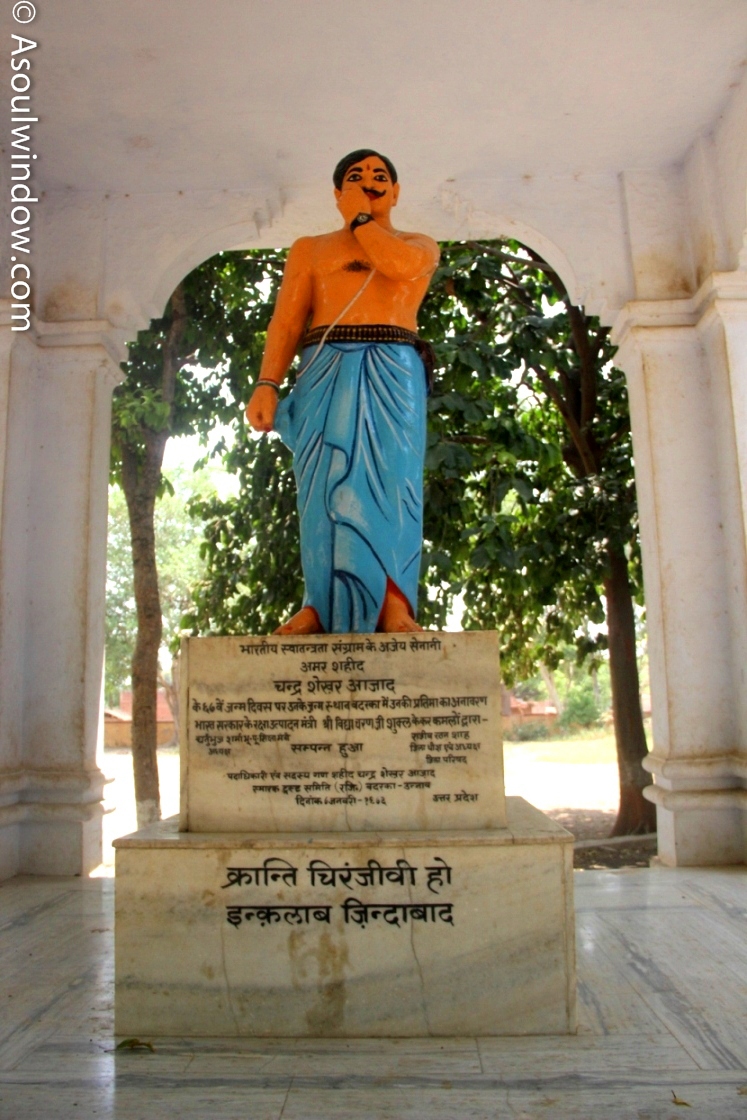
WARNING: COPYRIGHT TO ALL THE IMAGES AND TEXT HERE REMAINS WITH ME. YOU CAN NOT JUST LIFT THE CONTENT AND USE IT WITHOUT MY PERMISSION. STRICT LEGAL ACTION WILL BE TAKEN IF CONTENT IS STOLEN. YES, I AM SERIOUS.
Top Travel Blogger from India
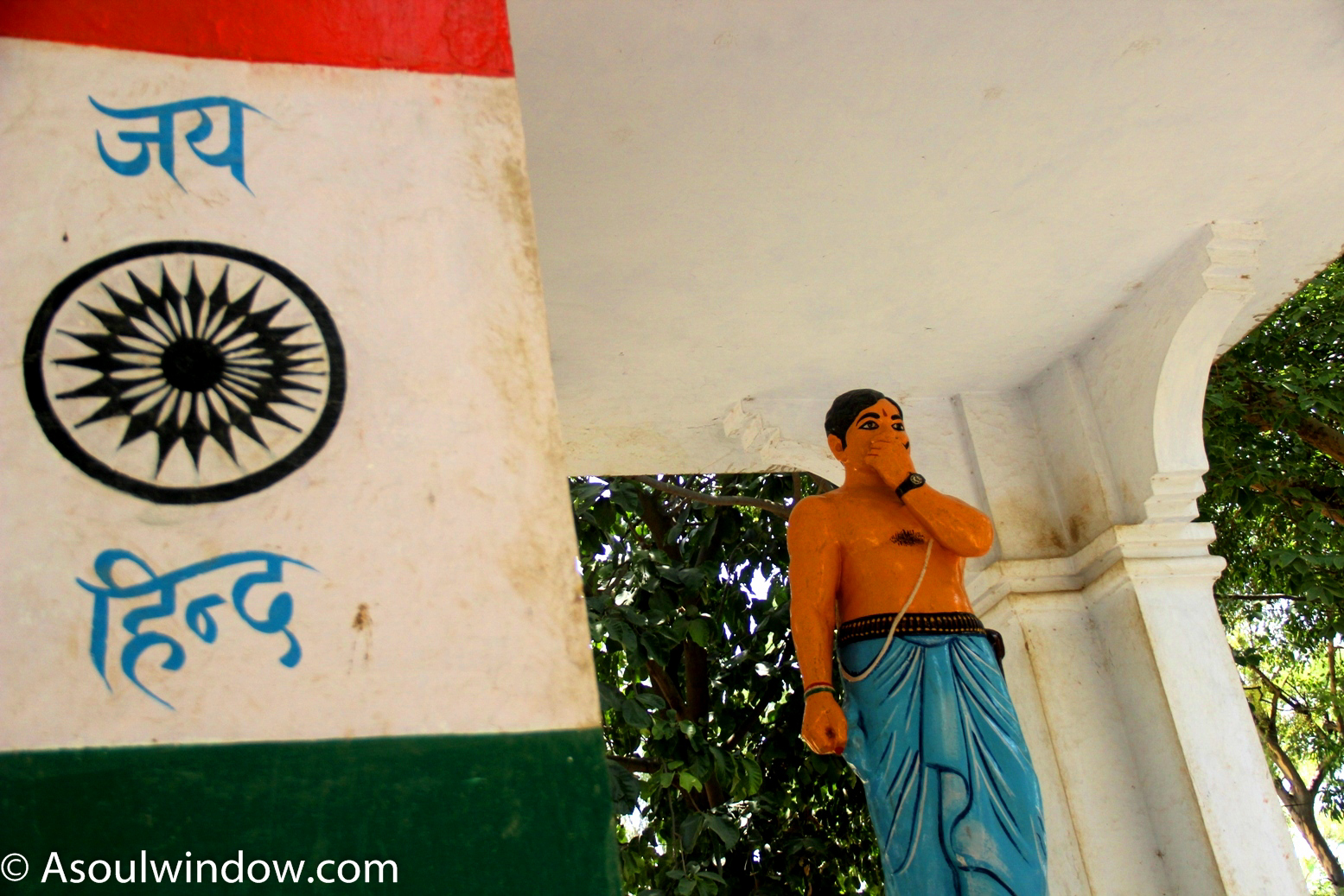
Pingback: Why I said no to New York Times – False propaganda writing on Kashmir! | A Soul Window - Top Travel Blog from India!
Pingback: HYATT REGENCY – ONE OF THE BEST 5 STAR HOTEL IN LUCKNOW ! | A Soul Window - Top Travel Blog from India!
Pingback: KERALA BLOG EXPRESS BOYCOTTED AND EXPOSED BY TOP INTERNATIONAL AND INDIAN TRAVEL BLOGGERS. GOD’S OWN COUNTRY? | A Soul Window - Top Travel Blog from India!
What a fascinating story to share! I always love to discover about other country’s culture and history!
Such an interesting story. I never knew there as a controversy about the place and date of birth of Azad. The story is so touching and brings to the fore everything that the family went through.
I have never read about Azad before. Thanks for your sharing this post! It just really updated my history knowledge. Good to know!
Fantastic one Abhinav. This piece is special as it brings alive all the sacrifices made not just by Shaheed Chandrashekar Azad but his family and friends. It is a fascinating read and your pictures compliment it perfectly.
I’ve never heard of Azad before, let alone the conjecture surrounding his birth date.
Thanks for sharing this little slice of history!
That is a very informative article. Most Indians are ignorant about the birthplace of Azad, thanks to your diligence and curiosity we now have the details. Rarely does one set off to find the truth behind our freedom fighters and this article just broke all the barriers.
Such a fascinating piece. Definitely opened my eyes to something now, I had no idea about most of these bits of history. Don’t you just love how travel and history are intertwined? You learn something new every day!
Nice piece of read on the life of Chandrashekhar Azad..completely liked how you have done the detailing. Great going..